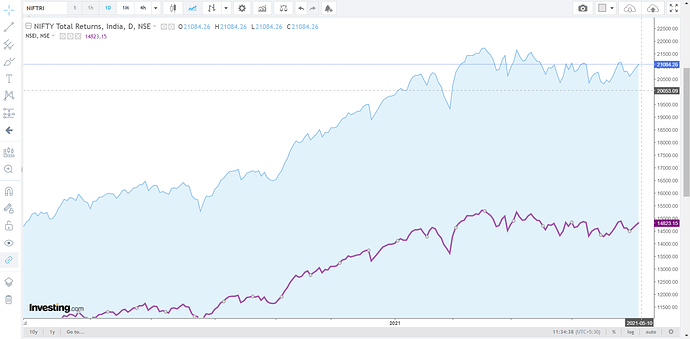In Nifty 50 ETF there are 50 corporates. SBI ETF Nifty 50 is an ETF wherein I have invested. Now during the year, there will be dividends that these corporates declare and SBI AMC who manage this ETF will receive the amount. I am aware that the expenses is taken out of this amount. The balance amount I am told will get invested which eventually get reflected in NAV. My query is, instead of NAV getting reflected which I have never seen due to dividends, why cant AMC give out the amount as additional units.
By giving out additional units, we as investors are aware that for FY 2020, we got 50 units additional due to dividends. This adjustment of dividends received to NAV is like drop of water in an ocean, cannot trace what and where.
SBI Nifty 50 ETF did recently make an exception and directly paid out 3 dividends of Rs. 1.3 (Notice 1, Notice 2, Notice 3). This was done so that EPFO could realize some of the gains but as dividends are now taxable in the hands of the shareholders, this will lead to higher tax outgo for people holding these ETFs -
Even if the dividends are paid out in the form of units instead of cash, TDS/taxes will still apply. This happens in the case of LiquidBees ETF -
Giving dividends in the form of cash or units likely isn’t tax-efficient any longer due to dividends being taxed at slab rates starting from FY 2020-21.
Also, ETFs track the Total Return Index (TRI) variant of the underlying index they are benchmarked against. Like the SBI Nifty 50 ETF follows the Nifty 50 TRI -
The TRI variant accounts for dividends paid by the underlying stocks. This can be seen when comparing the value of Nifty 50 Index vs the Nifty 50 TRI Index (Source - Investing.com) -
The 6000 point difference between the index and the TRI variant is due to the dividend being accounted for by the Total Return Index. This is mentioned in the Scheme Information Document of another Nifty ETF (NiftyBees - Page 28) -
TRI - Total Returns Index reflects the returns on the index arising from (a) constituent stock price movements and (b) dividend receipts from constituent index stocks.
Lastly, from what I am to understand, as the ETFs are benchmarked against the TRI variant which already accounts for the dividends, the dividend that is received from the underlying stocks is only used to create additional units of the ETF when its re-invested back. I am not completely clear/sure about this, so feel free to correct me.
I think Paying out actual dividends is more cumbersome then beneficial to investor:
- Dividend now is taxable. So you will have to account for this dividend income and pay tax each year.
- lot of time dividend amount would be such that payout needs to be made in fractional units. redeeming these fractional units is big pain.
Also the whole process would add lot of overhead as every time an index company declares dividend, ETF will have to provide dividend units (probably 50-100 times a year). Doing such administration work itself will result in costs going up.
aah… now i know why i recieved dividend from sbi mf… it was for this ![]()
Niftybees never gives dividends so does it mean they reinvest the dividends in the scheme itself and the same is added to the NAVs ?
If it gets added to the NAV then it will be equal to the dividend yield of Nifty which is currently 1.41%, you can check on ‘tickertape’.
Yes, the dividend is reinvested back in the ETF and gets reflected in the NAV. In case you are interested, this post explains how this happens with an example.

